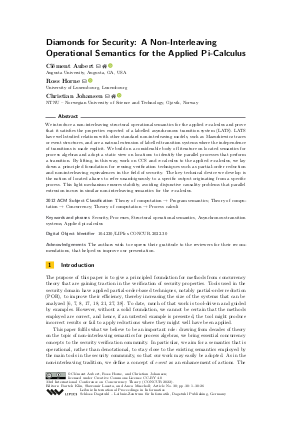@InProceedings{aubert_et_al:LIPIcs.CONCUR.2022.30,
author = {Aubert, Cl\'{e}ment and Horne, Ross and Johansen, Christian},
title = {{Diamonds for Security: A Non-Interleaving Operational Semantics for the Applied Pi-Calculus}},
booktitle = {33rd International Conference on Concurrency Theory (CONCUR 2022)},
pages = {30:1--30:26},
series = {Leibniz International Proceedings in Informatics (LIPIcs)},
ISBN = {978-3-95977-246-4},
ISSN = {1868-8969},
year = {2022},
volume = {243},
editor = {Klin, Bartek and Lasota, S{\l}awomir and Muscholl, Anca},
publisher = {Schloss Dagstuhl -- Leibniz-Zentrum f{\"u}r Informatik},
address = {Dagstuhl, Germany},
URL = {https://drops.dagstuhl.de/entities/document/10.4230/LIPIcs.CONCUR.2022.30},
URN = {urn:nbn:de:0030-drops-170930},
doi = {10.4230/LIPIcs.CONCUR.2022.30},
annote = {Keywords: Security, Processes, Structural operational semantics, Asynchronous transition systems, Applied pi-calculus}
}

 Creative Commons Attribution 4.0 International license
Creative Commons Attribution 4.0 International license







